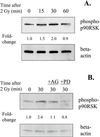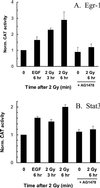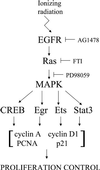Epidermal growth factor receptor dependence of radiation-induced transcription factor activation in human breast carcinoma cells
- PMID: 12134064
- PMCID: PMC117308
- DOI: 10.1091/mbc.01-12-0572
Epidermal growth factor receptor dependence of radiation-induced transcription factor activation in human breast carcinoma cells
Abstract
Ionizing radiation (1-5 Gy) activates the epidermal growth factor receptor (EGFR), a major effector of the p42/44 mitogen-activated protein kinase (MAPK) pathway. MAPK and its downstream effector, p90 ribosomal S6 kinase (p90RSK), phosphorylate transcription factors involved in cell proliferation. To establish the role of the EGFR/MAPK pathway in radiation-induced transcription factor activation, MDA-MB-231 human breast carcinoma cells were examined using specific inhibitors of signaling pathways. Gel-shift analysis revealed three different profile groups: 1) transcription factors that responded to both radiation (2 Gy) and epidermal growth factor (EGF) (CREB, Egr, Ets, and Stat3); 2) factors that responded to radiation, but not EGF (C/EBP and Stat1); and 3) those that did not respond significantly to either radiation or EGF (AP-1 and Myc). Within groups 1 and 2, a two- to fivefold maximum stimulation of binding activity was observed at 30-60 min after irradiation. Interestingly, only transcription factors that responded to EGF had radiation responses significantly inhibited by the EGFR tyrosine kinase inhibitor, AG1478; these responses were also abrogated by farnesyltransferase inhibitor (FTI) or PD98059, inhibitors of Ras and MEK1/2, respectively. Moreover, radiation-induced increases in CREB and p90RSK phosphorylation and activation of Stat3 and Egr-1 reporter constructs by radiation were all abolished by AG1478. These data demonstrate a distinct radiation response profile at the transcriptional level that is dependent on enhanced EGFR/Ras/MAPK signaling.
Figures










Similar articles
-
The epidermal growth factor receptor pathway mediates resistance to sequential administration of radiation and chemotherapy in primary human glioblastoma cells in a RAS-dependent manner.Cancer Res. 2002 Aug 1;62(15):4307-15. Cancer Res. 2002. PMID: 12154034
-
Dominant negative EGFR-CD533 and inhibition of MAPK modify JNK1 activation and enhance radiation toxicity of human mammary carcinoma cells.Oncogene. 1999 Aug 19;18(33):4756-66. doi: 10.1038/sj.onc.1202849. Oncogene. 1999. PMID: 10467423
-
Increased expression of epidermal growth factor receptor induces sequestration of extracellular signal-related kinases and selective attenuation of specific epidermal growth factor-mediated signal transduction pathways.Mol Cancer Res. 2003 Jan;1(3):219-33. Mol Cancer Res. 2003. PMID: 12556561
-
Radiation-induced release of transforming growth factor alpha activates the epidermal growth factor receptor and mitogen-activated protein kinase pathway in carcinoma cells, leading to increased proliferation and protection from radiation-induced cell death.Mol Biol Cell. 1999 Aug;10(8):2493-506. doi: 10.1091/mbc.10.8.2493. Mol Biol Cell. 1999. PMID: 10436007 Free PMC article.
-
Steering tumor progression through the transcriptional response to growth factors and stroma.FEBS Lett. 2014 Aug 1;588(15):2407-14. doi: 10.1016/j.febslet.2014.05.036. Epub 2014 May 27. FEBS Lett. 2014. PMID: 24873881 Free PMC article. Review.
Cited by
-
Interleukin enhancer-binding factor 3 promotes breast tumor progression by regulating sustained urokinase-type plasminogen activator expression.Oncogene. 2013 Aug 22;32(34):3933-43. doi: 10.1038/onc.2012.414. Epub 2012 Sep 17. Oncogene. 2013. PMID: 22986534 Free PMC article.
-
Expanding the Spectrum of Pancreatic Cancers Responsive to Vesicular Stomatitis Virus-Based Oncolytic Virotherapy: Challenges and Solutions.Cancers (Basel). 2021 Mar 9;13(5):1171. doi: 10.3390/cancers13051171. Cancers (Basel). 2021. PMID: 33803211 Free PMC article. Review.
-
Palliative radiotherapy in locally advanced head and neck cancer after failure of induction chemotherapy: comparison of two fractionation schemes.Indian J Palliat Care. 2013 Sep;19(3):139-45. doi: 10.4103/0973-1075.121522. Indian J Palliat Care. 2013. PMID: 24347903 Free PMC article.
-
Inhibition of ERK1/2 or AKT Activity Equally Enhances Radiation Sensitization in B16F10 Cells.World J Oncol. 2018 Feb;9(1):21-28. doi: 10.14740/wjon1088w. Epub 2018 Mar 8. World J Oncol. 2018. PMID: 29581812 Free PMC article.
-
Targeting inflammatory pathways for tumor radiosensitization.Biochem Pharmacol. 2010 Dec 15;80(12):1904-14. doi: 10.1016/j.bcp.2010.06.039. Epub 2010 Jun 30. Biochem Pharmacol. 2010. PMID: 20599771 Free PMC article. Review.
References
-
- Albanese C, Johnson J, Watanabe G, Eklund N, Vu D, Arnold A, Pestell R. Transforming p21ras mutants and c-Ets-2 activate the cyclin D1 promoter through distinguishable regions. J Biol Chem. 1995;270:23589–23597. - PubMed
-
- Andrisani OM. CREB-mediated transcriptional control. Crit Rev Eukaryot Gene Expr. 1999;9:19–32. - PubMed
-
- Beier F, Taylor AC, LuValle P. The Raf-1/MEK/ERK pathway regulates the expression of the p21(Cip1/Waf1) gene in chondrocytes. J Biol Chem. 1999;274:30273–30279. - PubMed
-
- Beier F, Taylor AC, LuValle P. Activating transcription factor 2 is necessary for maximal activity and serum induction of the cyclin A promoter in chondrocytes. J Biol Chem. 2000;275:12948–12953. - PubMed
Publication types
MeSH terms
Substances
Grants and funding
LinkOut - more resources
Full Text Sources
Medical
Research Materials
Miscellaneous

